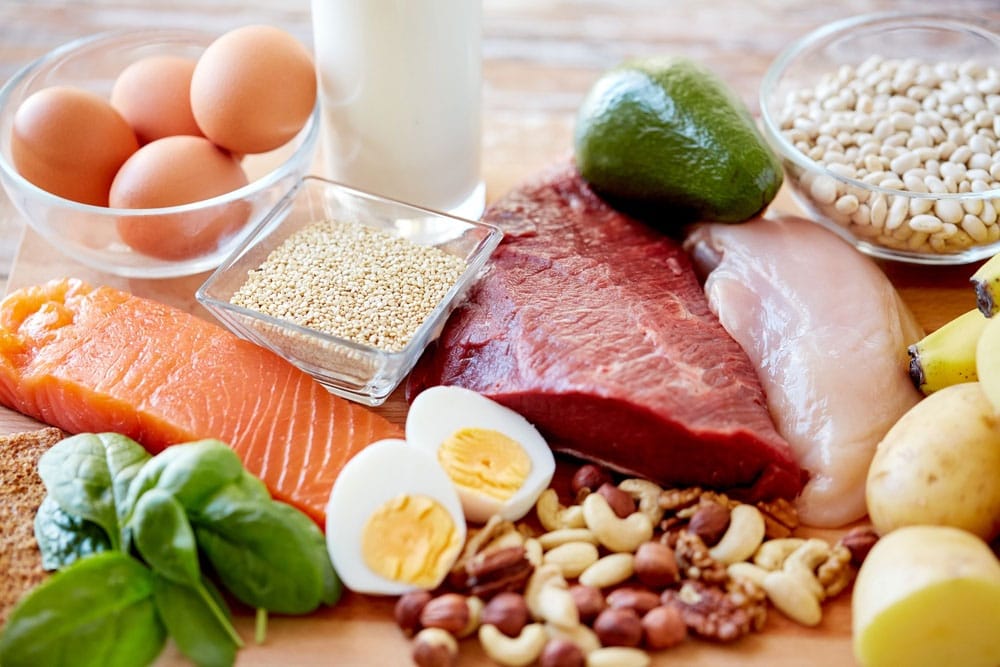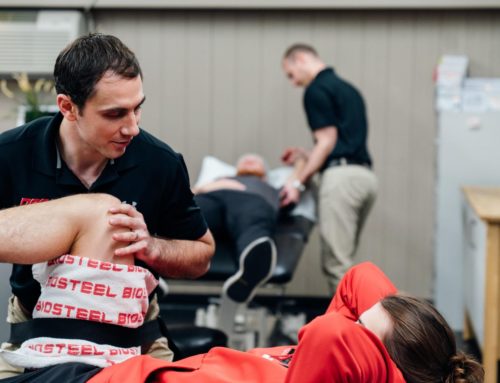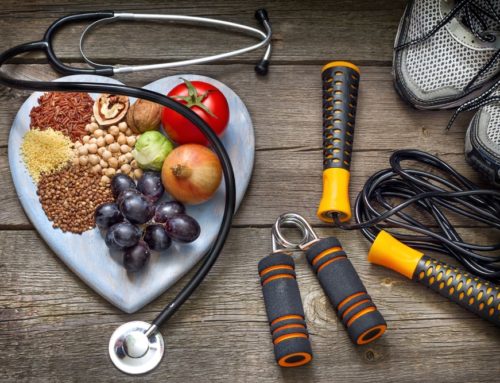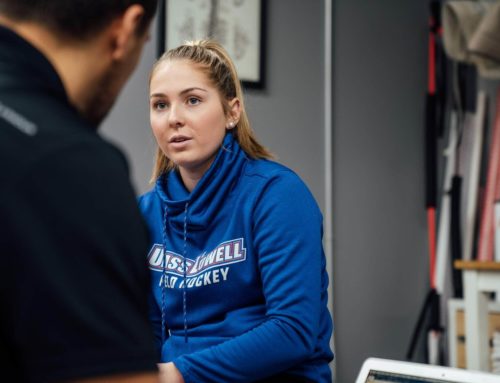This post is for young athletes and hockey players looking to improve their nutrition habits so they can add some much needed muscle to their frames in preparation for junior camps this spring and fall. The information below is provided to help these athletes with this ‘weight gain’ and muscle building process. When it comes to adding pounds, a sound nutrition strategy must go hand in hand with your training. You need to train to provide your body with a reason to build muscle and you need to eat properly to provide your body with the tools to build muscle. Think of training as the blueprint and nutrition as the building blocks.
These strategies are designed to be simple and easy to follow. They are derived from a variety of excellent nutritional resources, research studies and our practical experience when working with athletes. Enjoy!
5 Nutrition Tips for Building Muscle
Now, before we begin to discuss how you can build muscle, let’s just talk about reasonable expectations for young athletes when it comes to weight gain and look at the term a little closer. I have heard kids in our facility talk about other kids who ‘put on 20 pounds in 2 months’ or other fables or muscle building glory from their peers. First of all, kids always exaggerate the truth – so don’t feel that because Johnny told you he put on 20 pounds eating 10 peanut butter and jelly sandwiches per day that you should follow the same strategy. Johnny may have gained 20 pounds (more like 10 in reality) but a large portion of this weight was likely body fat – making Johnny bigger, but also slower and less powerful.
When it comes to weight gain, or more importantly muscle building – 0.5 – 1 lb of muscle gain per week is great progress. Hunh? Seems too slow for you? Not as fast as what our boy Johnny claims? Let’s look at it a little bit closer.
Our off-season training program for hockey players is 18 and 19 weeks respectively. All of our players are provided with detailed nutrition information, seminars, strategies, meal plans and post-workout supplementation. Nutrition is something we take very seriously as an integral part of our summer training program.
0.5 lb per week x 18 weeks = 9 lbs of added muscle mass
1 lb per week x 18 weeks = 18 lbs of added muscle mass
Now while this may not be as rapid as Johnny’s 20 pound PB and J diet, our athletes are more likely to have gained muscle not just added weight by packing on unnecessary and counter- productive body fat. When you add weight to the body, it is going to require more strength to move it explosively around the ice. This is especially true in a sport such as hockey where you need high amounts of relative strength to propel your own mass around the ice at a high speed to wreak havoc on the opposition. If I have simply become fat and slow, without getting stronger – this does not improve my outcomes as a hockey player. This is why the NUTRITION STRATEGY you select for adding weight it vital to your success not only with weight gain, but as a hockey player.
So I hope this has now provided you with the right frame of reference to read the information below.
Muscle Tip #1:
Stay Hydrated. Your muscle tissue is primarily composed of water and it needs proper hydration to recover and grow. Sounds boring? Without proper hydration your cells do not communicate with each other as quickly, this slows down the signalling process when it comes to building muscle. Staying hydrated is a pre-requisite for muscle building activity in the body. Building muscle is a cellular process – the healthier the cells, the faster the process can operate. If you are training and eating protein but are in a dehydrated state, you are missing out on potential results.
Solution: Drink a minimum of 4 large glasses (500mL) of water per day in addition to your workout shakes. Juice, coffee, soda do NOT count (I hope our athletes are not drinking SODA to stay hydrated – if so I have failed miserably thus far).
Strategy: 1 Large glass in the morning, 1 large glass mid-morning, 1 large glass 30 minutes prior to training and 1 large glass before bed. Also, drinking a large glass of water 15 minutes prior to eating as opposed to with your meal is said to improve digestion ability – so give it a try, it’s worth a shot.
Muscle Tip #2:
Never, Ever, Ever Miss Breakfast. Your body is in a breakdown state after sleep and it needs nutrition upon waking up to start to building process again. The longer you go without putting nutrition into your body, the less muscle you will be able to build and maintain. Wake up and get ANABOLIC (this means in a muscle building state kids) by eating breakfast!
Solution: We recommend the Poloquin (he is a world class strength coach kids) meat, nut and fruit breakfast to add lean muscle mass and improve body composition. This meat and nut breakfast also helps to stabilize blood sugar promoting fat loss, as well as increases dopamine and acetylcholine – 2 neurotransmitters in the brain required for mental alertness and clarity. This will also help to ensure your brain neurotransmitters are primed for the strength training sessions ahead in the day.
Strategy: Note: do not add anything to these breakfasts, no grains or cereal or toast or juice. You should have had your glass of water 15 minutes prior to breakfast which will aid in digestion – but do not add anything else (coffee, green or herbal tea is acceptable).

Muscle Tip #3:
Eat more. Eat early. Eat often. If you want to get bigger then you need to be eating, almost all the time. As a general rule, if you are not eating then you are not growing. Now this does NOT give you the okay to just eat whatever you want all the time. Remember, you are trying to gain muscle mass, not just increase body fat. A bigger but fatter athlete is not a superior athlete so make sure you stick to healthy, nutrient dense food when trying to gain weight. NEVER skip breakfast and always be prepared.
Solution: Have a high calorie/nutrient dense food source to snack on when between meals (ie. Nut and fuit mix). Remember, you are going to need to be eating all the time. That means you need a plan for having a way to get food during periods where it is difficult to eat, such as in class or on road trips. Have a high calorie snack ready.
Strategy: One recommendation is to have some mixed nuts (almonds, cashews, walnuts, pecans) and dried fruit (apricots, raisins, banana, pineapple, mango, coconut flakes, etc) available to eat. This is an excellent high calorie, nutrient dense snack to eat during times like these! Try adding some 85-95% dark chocolate pieces too. Grab 1 big handful, get it in your body and carry on with your day. Just avoid eating the entire mix all in one sitting – you can still get fat from implementing the strategy incorrectly. Use 1 big handful, 2-3 times a day between meals.
Muscle Tip #4:
Do not miss out on your work-out nutrition and supplementation. Research has shown the time surrounding your training session is very valuable when it comes to building muscle and for this reason we provide our athletes with pre and post workout supplements at Depth Training. Resistance exercise improves the sensitivity of our muscles for using fast-digesting protein (such as the type of protein found in protein supplements) as the building blocks for creating new muscle tissue. This 1-2 hour window after a resistance training session is the BEST time to have your protein supplement.
Solution: Never finish your training session without nourishing your body with a whey protein shake in the first 30 – 60 minutes after its completion. The best strategy is to think of your shake as the last exercise in your workout – the session is not over until you have had your shake!
Strategy:
Post Workout – 1 scoop (20-30 grams) of Whey Protein Isolate in 500 mL of water. This is the minimum requirement. Most ‘gainer supplements’ have added carbohydrates in them and lots of additional sugar which may or may not be beneficial for recovery and building muscle. Most young athletes can use some added carbohydrates in their recovery drink, which you will find in Biosteel’s Advanced Recovery Formula. The take home message is for our athletes to first start getting in the habit of drinking a recovery drink with protein after EVERY workout. The rest of the details can be discussed after this step is mastered.
Muscle Tip #5:
Choose Nutrient Dense Foods at ALL times. These foods will help increase the body’s ability to build muscle tissue and will help make sure your added mass is from muscle and not just body fat. Do not make the mistake of just eating ANY FOOD simply for the sake of eating – SMART CHOICES MATTER EVEN WHEN TRYING TO ADD WEIGHT.
Solution: Avoid Eating low nutrient, high calorie foods (fast food, chocolate bars, cereals, candy, chips, donuts, high sugar foods, etc) simply for the sake of eating because you feel you need to ‘gain weight’. This strategy will leave you FAT, SLOW, De-Conditioning and no closer to your goal of adding muscle. THIS IS THE MOST COMMON MISTAKE OF YOUNG ATHLETES, do not make it.
“Nourish the body, do not just overfeed”
Top 10 Muscle Building Foods
- Lean meats – chicken, beef, bison, game (venison), turkey, lamb
- Atlantic Salmon
- Coconut Oil
- Quinoa
- Nuts – walnuts, almonds, hazel nuts, brazil nuts, cashews, pecans
- Blueberries, raspberries, blackberries, strawberries
- Kiwi, Mango, Peaches
- Asparagus
- Cinammon
- Tumeric Spice
Other great foods include: eggs, organic whole flake oats, whey protein supplements, organic/natural cheeses, spinach, kale, sweet potatoes/yams.
Some Additional Tips and Strategies:
Get 8-10 hours of sleep each night. Sleep helps you to repair and recover. Recovery is the time when you build muscle. Without sleep there is no recovery and no muscle growth. Remember an exercise is only as effective as your ability to recover from it. You want to increase muscle? Then get some shut eye.
Take naps when possible. This is an effective way to give your body an anabolic surge and help it put on muscle. The best time to nap is afte
r you have had your post-workout meal. This will help your body to digest the food and begin the muscle repair process immediately. Get in the habit of taking naps to help you build muscle.
Get 5 hours of exercise each week. Do NOT forget to train! Even though you are trying to gain weight, we want it to be lean healthy muscle, so you need to make sure you are exercising with resistance training to give your body a stimulus for muscle growth.
Take BCAA (Branch Chain Amino Acids – a major component of Biosteel HPSD) between meals (breakfast and lunch and/or lunch and dinner) to prevent muscle breakdown. When looking to build muscle and grow, you want to make sure your body is never in a catabolic or breakdown state. When you begin to fast, your body loses some of its anabolic momentum and can start to breakdown muscle tissue. When looking to add muscle and grow, we want to avoid this catabolic state at all costs. Aim for 9-12 grams of BCAA supplement per day.
Eat Frequently. If you are not eating, you are not growing. Your food choices matter, but you want to make sure you are providing your body with frequent intakes of nutrient dense food. Try setting a timer on your phone or ipod – when it goes off every 2.5 to 3 hours, be sure to get some lean protein, vegetables and healthy fats into your system. Your goal is to get 5-7 ‘feedings’ per day. A feeding includes breakfast, morning snack, lunch, afternoon snack, workout supplements, dinner, pre-bed snack. Your goal to add muscle is 7 feedings per day, all containing a good source of protein.
Finally, for those of you who seriously need to add mass, over-activity can lead to excessive calorie burning and a more difficult time gaining muscle. The following behaviour strategy (outside the gym – as I can already hear the comments from certain athletes) can be very helpful in looking to increase muscle in the ‘hard to gain’ population:
- Never run when you can walk
- Never walk when you can get a ride
- Never stand when you can sit
- Never sit when you can lie down
- Never lie down when you can go to sleep
Take Home Message:
Training and nutrition go hand in hand. If you are seriously looking to add some muscle this off-season you need to start paying as much attention to your nutrition as your training. Train hard, eat well and eat often.
Stay tuned for more muscle building nutrition strategies and recipes in the future. As a quick check list, start with the following and do them consistently. This is your starting point. Start here and I guarantee you will notice results.
Nothing is better than a consistent training program and consistent eating habits. Consistency may be the most difficult part of training and nutrition to master, but it is also the most effective!
Good Luck!
Written by: Justin Brooks, Partner, Director of Athletic Development, Physiotherapist






